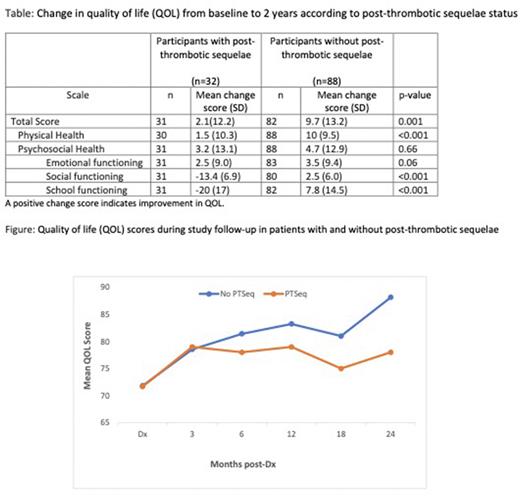Abstract
Background/objectives: We prospectively measured change in the quality of life (QOL) in children during the 2 years after first-episode, acute venous thromboembolism (VTE) and evaluated predictors of QOL, including the impact of post-thrombotic sequelae on QOL.
Patients/methods: Consecutive patients with acute VTE were recruited from 2016 to 2022 for the TOP (Thrombosis Outcomes in Pediatrics) study (ClinicalTrials.GOV ID: NCT03068923). A pre-planned QOL analysis was conducted at study visits at diagnosis and 3, 6, 12, 18, and 24 months. Patients with cancer, recurrent VTE, sickle cell disease, and those not anticoagulated were excluded. At each visit, a standardized assessment for post-thrombotic sequelae (recurrence, post-thrombotic syndrome (PTS), post-pulmonary embolism (PE) syndrome, portal HTN, and post-CSVT recovery) was performed, and participants self-completed QOL questionnaires using the Peds QoL. Mean within-patient change scores (baseline to 2 years) were assessed using paired t-tests (Hο: Δ = 0), where positive change scores indicate improvement in QOL. Change in QOL over time was assessed in the entire cohort and was compared between patients with and without adverse post-thrombotic sequelae. Predictors of QOL were evaluated, and the influence of post-thrombotic sequelae on QOL at two years was assessed using multivariable regression analyses.
Results: Among the 120 children prospectively recruited, the median age was 13 years (range 0-18). 56% were males (n=66) and 28% were Hispanics. The most common VTE site was lower extremity DVT (41%), and 80 % had a provoked event. 15% had comorbidities. The cumulative incidence of adverse post-VTE outcomes at 2 years was 26% (10 children within the entire cohort developed recurrence identified objectively, 5 of 67 with extremity thrombosis had clinically significant PTS as assessed with the Manco-Johnson Instrument instruments, 9 of 36 with PE had post-PE exercise intolerance on cardiopulmonary exercise testing, 2 of 9 with portal vein thrombosis developed portal HTN and 4 of 23 with CSVT had impaired neurocognitive recovery measured by the pediatric stroke recurrence and recovery questionnaire). QOL scores below the population mean were documented at diagnosis (32%), 3 (37%), 6 (20%),12 (23%), 18 (19%) and 24 (13%) months. On average, QOL scores improved during follow-up, with most improvement occurring in the first six months following post-diagnosis. However, patients who developed adverse post-thrombotic sequelae had lower scores at all visits and significantly less improvement in QOL over time. Multivariable regression analyses showed that female sex (p=0.01), non-extremity thrombosis (p=0.008), presence of post-thrombotic sequelae (p=<0.001) and long-term anticoagulation (p=<0.001) independently predicted 2-year post-diagnosis impaired QOL.
Conclusions: We evaluated QOL during the 2 years following an episode of acute We found that, on average, QOL scores tended to improve during follow-up and that most of the improvement in QOL occurred in the first 6 months after VTE. However, patients who developed post-thrombotic sequelae had poorer QOL, less overall improvement in QOL, and slower improvement in QOL.
Our findings are of direct importance to patients. On average, patients with VTE who do not develop post-thrombotic sequelae can expect that at 2 years, their QOL will improve to a level like that of the general population. Further, our study provides prognostic information on patient-reported outcomes after VTE and emphasizes the need for effective prevention and treatment of the post-thrombotic sequelae.
Disclosures
No relevant conflicts of interest to declare.
Author notes
Asterisk with author names denotes non-ASH members.


This feature is available to Subscribers Only
Sign In or Create an Account Close Modal